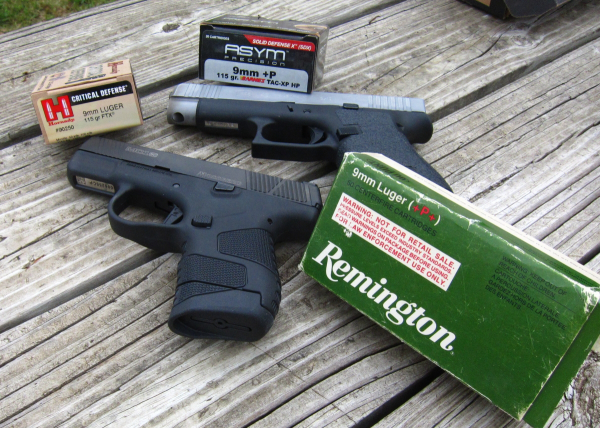
Ever wonder about the effects of age on “old” ammo? Or wonder if the “law enforcement only” +P+ loads of old actually measure up to current standard pressure or SAAMI +P standards of today?
Well, pressure is pressure and velocity is velocity. More of one doesn’t always equal more of the other. Velocity can be a problem in terms of ballistic effectiveness on various targets depending on bullet construction; too fragile a bullet driven too fast or too robust a bullet going too slow -- generally. Still one expects that more pressure should usually give more velocity – as well as recoil and blast.
The ammo under examination here is Remington R9MM4, a box I purchased from a small town hardware store in the early 1990s -- marked “+P+” -- it’s 115 grain JHP ammo. It’s prominently marked that it’s for Law Enforcement Only, which is largely due to potential liability if someone wore their personally owned gun shooting it. I decided to try it out against the (sadly) discontinued ASYM +P 115 gr. Barnes TAC-XP HP load and the current Hornady Critical Defense 115gr. FTX rounds out of two guns: the 4.17” barrel of the GLOCK 48 and the shorter 3.4″ barrel of the Mossberg MC1SC.
Velocities, Old Ammo and “New” – speed in feet-per-second, noting extreme spread of velocities in each string.
|
Ammo brand/type |
G48 Avg Vel |
G48 ES |
MC1SC Avg |
MC1SC ES |
|
Remington R9MM4 +P+ |
1234 |
37 |
1210 |
40 |
|
ASYM +P 115 Barnes TAC-XP |
1133 |
19 |
1180 |
14 |
|
Hornady Critical Defense 115 FTX |
1135 |
21 |
1128 |
41 |

We don’t see a crushing advantage for the extra pressure of the R9MM4 LE load, only around 100 fps faster in the service/compact length – nearly .8” longer barrel - of the G48 and only around 60 fps advantage in the shorter MC1SC over non-high pressure loads. I didn’t notice any significant blast or recoil difference from the higher pressure load. Take into consideration that the ASYM ammo was only a few years old, the Hornady ammo was from the last couple of years – and that Remington ammo was nearly 30 years old. The age could make a difference.
The ES – extreme spread measurement – was certainly well within standards showing the ammo was consistent round-to-round.
I’m not seeing anything in the way of regular “+P+” availability these days – and I don’t miss it. Chamber pressure standards are what they are and the industry regulates the standards appropriately for safety. Now the only issue seems to be “+P” versus “standard pressure.”
That’s more interesting data in the chart for me. The ASYM load seems to be only slightly faster than the Hornady Critical Defense load in the Mossberg. In the GLOCK 48, it’s a wash: less pressure, essentially the same speed. The question you’d have to answer is which bullet has superior effects on the expected targets – or, more important, which load hits closest to the sights in your particular gun.

After over 20 years of “chronography,” I’m not particularly surprised by the results. On the same day at the range, I took a look at 22 LR ammo from a recently released pistol, the Taurus TX22. Those results follow –
TX22
|
Ammo Brand/type |
Avg vel. |
ES |
|
Remington Golden Bullet |
928 |
126 |
|
CCI Mini-Mag |
991 |
37 |
|
CCI Stinger |
1210 |
50 |
I did this as a check against the chronograph based on the environment on that day at the range. The ammo came in as expected out of the just-over 4” barrel of the Taurus. For interest, the Mini-Mag advertised velocity is 1235 fps and the CCI Stinger advertised velocity is 1640 fps – those data likely collected in a longer barrel, either a test fixture or a rifle barrel.
When examining ammunition for velocity, remember that barrel length, environmental conditions, and the individual chronograph all play a part in the results.
- - Rich Grassi